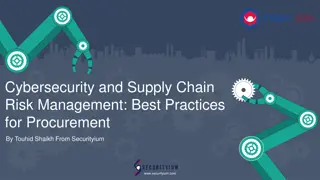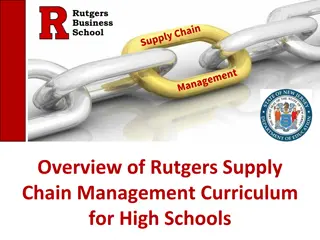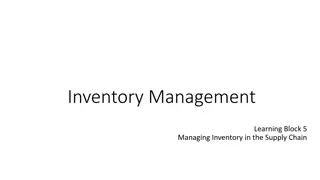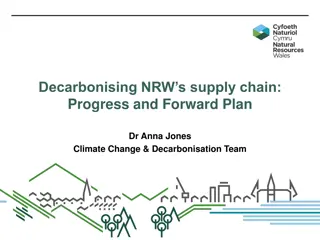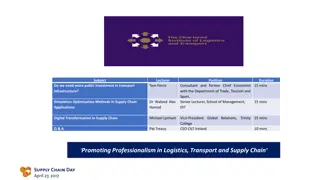
How to Manage Supply Chain Disruptions Navigating the Challenges
In today's interconnected world, a smooth-running supply chain is the backbone of any successful business. It's the intricate network that transforms raw materials into finished products, ultimately reaching customers across the globe. However, this
Download Presentation

Please find below an Image/Link to download the presentation.
The content on the website is provided AS IS for your information and personal use only. It may not be sold, licensed, or shared on other websites without obtaining consent from the author. Download presentation by click this link. If you encounter any issues during the download, it is possible that the publisher has removed the file from their server.
E N D
Presentation Transcript
How to Manage Supply Chain Disruptions? Navigating the Challenges In today's interconnected world, a smooth-running supply chain is the backbone of any successful business. It's the intricate network that transforms raw materials into finished products, ultimately reaching customers across the globe. However, this delicate dance can be disrupted by unforeseen events, causing delays, stockouts, and price fluctuations. Understanding these disruptions and implementing effective mitigation strategies is crucial for businesses to ensure resilience and maintain a competitive edge. What are Supply Chain Disruptions? A supply chain disruption is any event that interrupts the flow of goods and services within a supply chain. This can occur at any stage, from sourcing raw materials to production, warehousing, and distribution. Disruptions can be caused by a variety of factors, both internal and external:
1.Internal Disruptions: These stem from inefficiencies within a company's own operations, such as: 2.Poor inventory management leading to stockouts or overstocking. 3.Production delays due to equipment failures or labor shortages. 4.Weak supplier relationships resulting in unreliable deliveries or quality issues. 5.External Disruptions: These are triggered by events outside of a company's control, including: 6.Natural disasters like hurricanes, earthquakes, or floods that damage infrastructure or disrupt transportation. 7.Geopolitical events like trade wars, sanctions, or political instability that restrict the movement of goods. 8.Public health crises like pandemics that lead to labor shortages or border closures.
9.Technological disruptions like cyberattacks that cripple critical systems. The Impact of Supply Chain Disruptions The consequences of supply chain disruptions can be far- reaching, impacting businesses, consumers, and the overall economy. Here's a closer look at some key areas: Business Impact: Disruptions can lead to production slowdowns, stockouts, and lost sales. Businesses may also experience increased costs due to factors like expedited shipping or sourcing alternative materials. Consumer Impact: Customers may face product shortages, delays in receiving orders, and potential price hikes due to limited supply. Economic Impact: Widespread disruptions can lead to inflation as demand outstrips supply. Additionally,
disruptions can hinder economic growth by impacting production and trade. Examples of Recent Supply Chain Disruptions The COVID-19 pandemic serves as a stark example of a global supply chain disruption. Lockdowns and travel restrictions caused labor shortages, factory closures, and port congestion, leading to significant delays and shortages of various goods. Additionally, the ongoing chip shortage has crippled production in various industries, from automobiles to electronics. These disruptions highlight the interconnectedness of modern supply chains and the vulnerability to unexpected events. Strategies to Mitigate Supply Chain Disruptions While unforeseen events are inevitable, businesses can implement proactive strategies to minimize the impact of supply chain disruptions: 1.Diversification: Sourcing raw materials and finished products from multiple suppliers across different geographical locations reduces reliance on any single source. 2.Inventory Management: Implementing robust inventory management practices with accurate forecasting helps maintain optimal stock levels to avoid stockouts during disruptions. 3.Supplier Relationships: Building strong relationships with reliable suppliers fosters trust and collaboration. This can involve joint planning exercises and communication channels to ensure transparency during disruptions.
4.Visibility and Transparency: Utilizing technology solutions for real-time tracking of inventory, shipments, and production processes provides valuable insights and enables proactive decision-making. 5.Scenario Planning: Developing contingency plans for various disruption scenarios allows businesses to react quickly and adapt their operations to minimize the impact. 6.Investing in Technology: Embracing automation and digital tools can streamline operations, improve efficiency, and enhance visibility across the supply chain. The Future of Supply Chain Management As the global economy continues to evolve, supply chains will become even more complex and interconnected. Emerging technologies like artificial intelligence and blockchain can
play a significant role in enhancing supply chain visibility, optimizing inventory management, and predicting potential disruptions. By embracing these advancements and implementing robust risk mitigation strategies, businesses can navigate the ever-changing landscape and ensure a more resilient supply chain. Conclusion Supply chain disruptions are a constant threat in today's globalized world. However, by understanding the potential causes, their impact, and implementing proactive mitigation strategies, businesses can build resilience and navigate these challenges effectively. By fostering strong supplier relationships, investing in technology, and maintaining a focus on visibility and transparency, companies can ensure a smooth flow of goods and services, ultimately delivering value to their customers and achieving long-term success.





